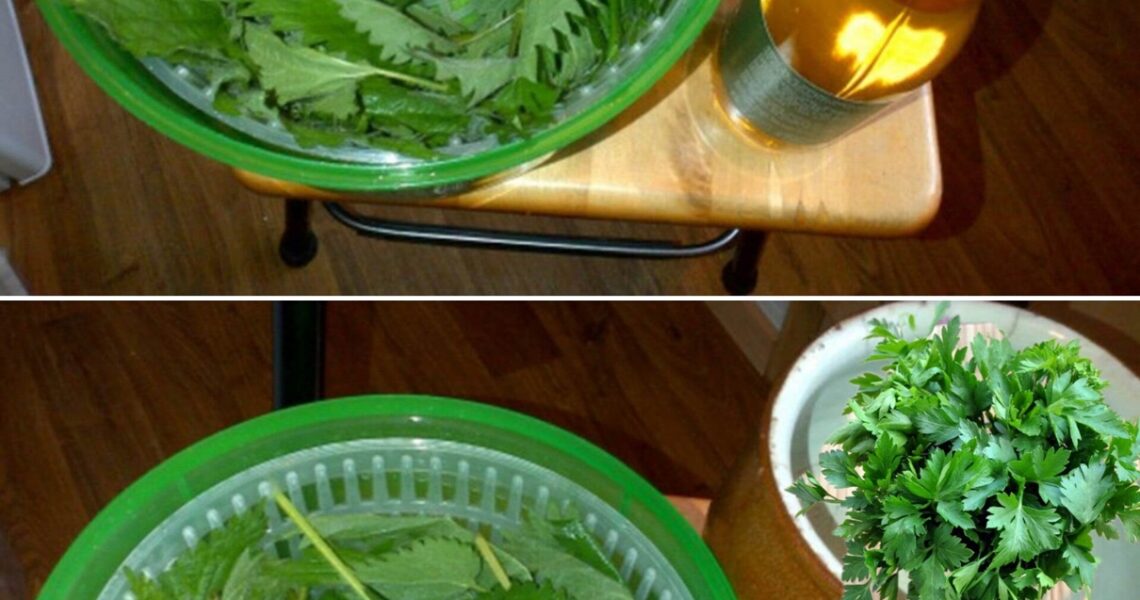Medicinal brandy with nettle and parsley for pain and swollen joints (bursitis)

This simple recipe includes two green herbs that are extremely healing, and when their active ingredients are extracted and combined, an extremely healing preparation is obtained for all those who suffer from leg and joint pain.
Here’s what you need for this natural remedy:
INGREDIENTS NEEDED:
1 handful of dry/fresh nettles (leaves),
1 handful dry/fresh parsley (leaves),
1 liter of grape brandy.
PREPARATION:
All ingredients are placed in a glass jar, then closed tightly and left for 15-20 days in a warm place.

The jar should be stirred or at least shaken daily.
After the expiration date, the brandy is filtered through cheesecloth, squeezed well and stored in a dark glass bottle with a well-closed cap.
This brandy is applied to painful and problematic places or used as a poultice (by soaking gauze or cotton cloth fixed with foil) for swollen joints.
Here’s what it’s used for, how to recognize the symptoms, and how to treat yourself:
SYMPTOMS:
Pain, inflammation, and swelling in the shoulders, elbows, hips, knees, or joints of the hands or feet, especially during stretching during exercise, lifting, or other stress on the joint beyond its normal capacity;
Limited range of motion of the joint, with or without immediate pain.
Where your bones, tendons, and ligaments move past each other, especially near the joints, the contact points are protected by fluid-filled sacs called bursae.
Each of the over 150 bursae in the body helps the joints function smoothly during all natural movements by reducing strain.
When a joint is overused or remains under pressure or tension for long periods of time, the nearest bursa can become inflamed.
The sac fills with extra fluid, causing pressure on the surrounding tissue.
The immediate signs are pain, often accompanied by inflammation, swelling and tenderness in the area.
Among the most common places bursitis affects is the shoulder, which has the greatest range of motion of any major joint in the body.
Chronic bursitis, which is not treated, can lead to the formation of calcium deposits in the normally soft tissues, sometimes causing permanent limitation of the mobility of the affected joint.
TREATMENT: Conventional medicine. Initial treatment usually consists of acetylsalicylic acid (eg aspirin) or non-steroidal anti-inflammatory drugs.
These pain relievers usually reduce inflammation. With the help of heat and ultrasound, the joint can be loosened and tissue regeneration can be accelerated.
Diathermy (deep heat treatment) under the guidance of a sports physician or board-certified physical therapist can not only relieve pain and inflammation caused by bursitis, but can also relieve tension in muscles, nerves, and tendons.
Bursitis can recur, especially if you regularly engage in heavy exercise or manual labor.
In such cases, the doctor may prescribe corticosteroid treatment in the form of oral medication, topical cream or injection into the affected joints.
In more severe cases, it may be necessary to draw fluid from the inflamed and swollen bursae with a hypodermic syringe to relieve pressure.
In case of long-lasting symptoms, the bursae can be surgically removed.
Herbal treatment.
To speed up blood flow, reduce inflammation and relieve muscle tension, an herbalist may recommend a 5 ml tincture taken three times a day consisting of the following herbs: 2 parts willow bark, potato peel and celery seed, together with one part of the herb Zanthoxylum americanum.
Mix equal amounts of lobelia and potato peel to make a tincture that you can rub into your muscles as needed to ease the tension associated with bursitis pain.
Eating
Vitamins C, A and zinc are recommended for the production of tissue-building collagen and the regeneration of damaged tendons and bursal tissues.
Rich food sources of vitamin C are citrus fruits and potatoes;
Cod liver oil is a good source of vitamin A. In addition, vitamin E is believed to effectively accelerate the healing of damaged tissue.
Follow the recommendations of a qualified nutritionist regarding the amount and duration of vitamin supplementation.
Another approach that is said to help with recurrent cases of bursitis involves vitamin B12 injections.
If you liked the article, you can follow us and share the post with your friends and your opinion (or experience) in the comments!
